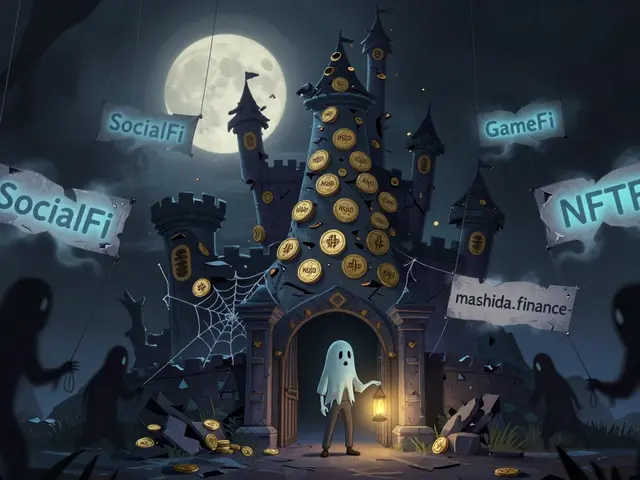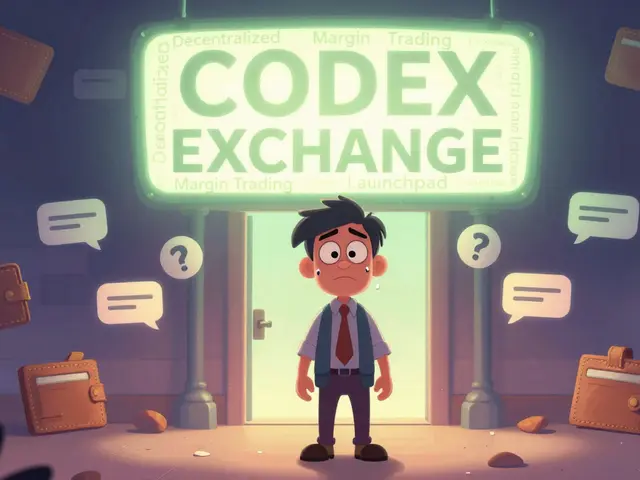5PT Staking Calculator
How 5PT Staking Works
When you stake 5PT, 100% of the tokens are permanently burned. In exchange, you earn daily rewards from the protocol's asset pools. This calculator estimates your potential returns based on your staking amount and expected daily reward rate.
Note: Actual returns may vary significantly. The token's market data shows volatility with price differences of up to 15% across exchanges. The project lacks public audit reports, verified asset holdings, and transparent team information.
Quick Takeaways
- Five Pillars Token (5PT) is a BEP‑20 token on Binance Smart Chain that burns 100% of staked tokens.
- It claims backing from five real‑world asset classes: precious metals, digital currencies, real estate, equity participation, and transaction‑fee ventures.
- Liquidity is locked, but daily trading volume is under $600k and market‑cap data vary across trackers.
- No public team details, audit reports, or independent reviews are available, making due‑diligence essential.
- If you decide to try it, use a BSC‑compatible wallet, add the contract address, and follow the staking steps outlined below.
Crypto enthusiasts constantly run into new tokens promising high returns. Five Pillars Token (5PT) is a deflationary, asset‑backed cryptocurrency built on Binance Smart Chain. The name suggests a link to five real‑world asset classes, but what does that mean for an everyday investor? This guide breaks down the token’s core idea, how it works technically, what the market data look like, and the biggest red flags you should watch before putting any money in.
What the Project Says It Is
According to the official description on major tracking sites, Five Pillars Token aims to combine DeFi staking rewards with tangible asset exposure. The token’s creators say the ecosystem rests on five pillars: precious metals, digital currencies, real estate, equity participation, and fee‑based ventures. In theory, each pillar should provide a slice of real‑world value that backs the token’s price, offering a safety net against pure speculation.
Technical Foundations
On the blockchain side, Binance Smart Chain (BSC) hosts the token as a BEP‑20 asset. The contract address is 0xe6cae4094352a670c3eb0fcbda17c898b71c7f2a, verified on multiple explorers. Because BSC uses a proof‑of‑stake‑authority model, transaction fees are low (usually under $0.001) and confirmations are fast, which makes the token easy to move between wallets and exchanges.
Deflationary Staking Model
The most distinctive feature is the deflationary staking mechanism. When you stake 5PT, the smart contract automatically burns 100% of the staked amount. That means the total supply shrinks every time someone participates, theoretically increasing scarcity. In return, the protocol distributes daily rewards generated from the underlying asset pools. The reward rate isn’t publicly disclosed in detail, but the project mentions nine progressive staking pools and a referral‑based multiplier that can boost earnings.

Asset‑Backed Claims
Five pillars are said to be represented by actual holdings:
- Precious metals - likely gold or silver reserves.
- Digital currencies - could be a basket of other crypto‑assets.
- Real estate - tokenised property assets.
- Equity participation - stakes in private or listed companies.
- Transaction‑fee ventures - income from platform fees and other services.
Market Data Snapshot (October 2025)
| Source | Price (USD) | 24‑hr Volume (USD) | 24‑hr Change |
|---|---|---|---|
| CoinGecko | 0.007173 | 157,897 | -5.73% |
| Binance | 0.007898 | 531,056 | +0.00% (no change reported) |
| Live Coin Watch | 0.008231 | 202,600 | +1.61% |
Note the stark inconsistencies: price differences of up to 15% across platforms and contradictory 24‑hour movement. Circulating supply is shown as zero on Binance, while other sites list a small supply and a market cap that fluctuates between $0 and a few hundred thousand dollars. Such data gaps suggest low liquidity and possible price manipulation.
Risks & Criticisms
Even if the token’s concept looks appealing, several red flags emerge:
- Team anonymity: No verified founders or developers are disclosed on the official pages.
- Audit opacity: The claim of “triple‑audited” isn’t backed by publicly available audit reports from firms like CertiK or Quantstamp.
- Liquidity concerns: Daily volume stays below $600k, making large trades risky; slippage can quickly erode returns.
- Asset‑backing verification: No documentation shows how the five asset classes are valued or stored.
- Regulatory exposure: Asset‑backed tokens can fall under securities regulations in the US and EU; without clear legal structuring, the token could face enforcement actions.

How to Buy, Store, and Stake 5PT
- Install a BSC‑compatible wallet (MetaMask, Trust Wallet, or Binance Chain Wallet).
- Add the token manually using the contract address
0xe6cae4094352a670c3eb0fcbda17c898b71c7f2a. The wallet will auto‑populate Five Pillars Token once the address is entered. - Purchase BNB on an exchange (Binance, KuCoin, etc.) and transfer it to your wallet - you’ll need BNB for gas.
- Swap BNB for 5PT on a BSC DEX such as PancakeSwap. Set a modest slippage tolerance (0.5‑1%) because of low liquidity.
- Navigate to the staking portal listed on the project’s website (usually a Web3 page). Connect your wallet, select a staking pool, and confirm the transaction.
- Remember: every staked token is burned, so the amount you lock up disappears from circulation. Rewards will be sent to your wallet daily.
For community support, the project maintains a Telegram group and a Twitter feed, both linked from the official site. No official customer‑service email is provided.
Future Roadmap & Outlook
The publicly‑shared roadmap mentions plans for a crypto debit card, a decentralized marketplace, community incentive programs, and a lottery system. No dates are attached, and there’s no evidence of development milestones (e.g., GitHub commits) to confirm progress. Compared with established asset‑backed projects like Tether Gold (XAUT) or Paxos Gold (PAXG), Five Pillars Token sits at the bottom of market‑cap rankings (#1,959‑4,317 depending on the tracker). Without transparent asset verification, a proven team, and solid liquidity, the token’s long‑term viability looks uncertain.
Bottom Line
If you’re curious about innovative DeFi models, Five Pillars Token offers an interesting experiment: a deflationary staking system tied to a claimed basket of real‑world assets. However, the lack of verifiable audits, anonymous developers, and volatile market data make it a high‑risk speculative play. Treat any investment as a small experiment-never allocate more than you can afford to lose, and consider diversifying into better‑documented asset‑backed tokens if the concept appeals to you.
Frequently Asked Questions
What blockchain does Five Pillars Token run on?
5PT is a BEP‑20 token on the Binance Smart Chain (BSC). This means it benefits from low fees and fast confirmations.
How does the deflationary staking work?
When you stake any amount of 5PT, the contract instantly burns the staked tokens, permanently reducing total supply. In exchange, the protocol distributes daily rewards from the five asset pools.
Is there proof of the five asset classes backing the token?
No independent audit or publicly accessible proof of holdings has been released. The project only states the intent to back the token with precious metals, digital currencies, real estate, equity participation, and fee‑based ventures.
Where can I buy and stake 5PT?
You need a BSC‑compatible wallet, BNB for gas, and then you can swap BNB for 5PT on PancakeSwap or another BSC DEX. After acquiring the token, use the project’s Web3 staking portal to lock it and earn rewards.
Is Five Pillars Token regulated?
There are no public statements about regulatory compliance, and the token could be subject to securities laws in jurisdictions like the US or EU, especially because it claims real‑world asset backing.






Paul Barnes
Looks like another hype machine disguised as a "real‑world backed" token. The burning mechanic sounds nice, but if the assets aren't audited it’s just smoke. Keep your eyes open.
Jireh Edemeka
Ah, the classic "deflationary" promise paired with invisible gold reserves. One has to admire the creativity, albeit misguided. The lack of third‑party audits is a glaring omission. Investors would do well to demand transparency.
Ty Hoffer Houston
I get why people are intrigued by a token that burns its own stake – it sounds like built‑in scarcity. Still, the real question is whether those five pillars truly exist. Without proof, it’s more speculation than security. If you decide to dip a toe, treat it like an experiment. Diversify and never put in money you can’t lose.
mike ballard
From a DeFi lens, 5PT’s burn‑on‑stake model is a novel liquidity‑shrink tactic 😏. It theoretically boosts tokenomics but also raises slippage risk in low‑volume pools.
Molly van der Schee
I understand the allure of backing crypto with tangible assets, especially in volatile markets. It’s a hopeful concept, though the evidence is thin. Maybe keep a tiny position just to see how it unfolds.
Mike Cristobal
Seriously, if a project can’t show its vaults, why should anyone trust it? Transparency is non‑negotiable in finance. Skip it and save yourself the headache 😤.
Tom Grimes
I have been watching the crypto space for years.
I always look for the basics first when a new token appears with big promises.
The Five Pillars token claims to be backed by gold, real estate, and other assets.
That sounds impressive on paper.
But the website does not show any audited proof of those holdings.
No third‑party reports mean we have to rely on the team’s word.
The team is anonymous, which adds another layer of doubt.
The contract burns every token you stake, reducing supply.
In theory that should make the remaining tokens more valuable.
However, if the underlying assets are not real, the scarcity is meaningless.
The daily trading volume is under $600k, which is very low for a token of this type.
Low liquidity can cause huge price swings and slippage.
Prices differ by up to 15% across trackers, indicating data inconsistency.
Without a clear audit, we cannot verify the asset‑backing claims.
Investing in such a project is a high‑risk gamble.
If you decide to put money in, only allocate an amount you can afford to lose.
Diversify your portfolio with proven assets.
Keep an eye on the roadmap updates, but treat them as optional.
In short, treat Five Pillars as a speculative experiment, not a stable investment.
Andrew Smith
I hear you, but the burn mechanic could actually create real value if the vaults were real.
Still, without proof it remains a gamble.
Joy Garcia
Oh, please! Another bleedin’ hype train pretending to be a gold mine.
It’s all smoke and mirrors.
Erik Shear
Liquidity is basically nonexistent.
Tom Glynn
DeFi experiments are fun 😊 but they need substance 🧐.
Johanna Hegewald
The token burns on stake, which reduces supply.
Rewards come from undisclosed asset pools, so the source is unclear.
Benjamin Debrick
One must, of course, consider the ontological implications of a token purportedly anchored to tangible assets, yet shrouded in opacity; indeed, the absence of verifiable audit reports renders any purported valuation, at best, a speculative construct, and at worst, a potential ruse.
Such ambiguity should give any prudent investor pause.
Jon Miller
Wow, that was deep, but honestly it sounds like buzz‑word soup to me.
Give me some real data or don’t bother.
Rebecca Kurz
If the regulators catch up, this could vanish overnight; the hidden risks are massive, and the lack of compliance is a red flag.
Elizabeth Chatwood
i think the token is kinda sus but hey maybe it works lol gotta watch the price.
John Lee
Curiosity drives the market, yet we must balance excitement with due diligence; exploring new models is great, but only if the foundations are solid, otherwise we’re just chasing mirages.
Nikhil Chakravarthi Darapu
From a national perspective, supporting home‑grown blockchain projects is vital, but it must not come at the expense of investor safety.
Transparent audits are non‑negotiable, and anonymity undermines trust.